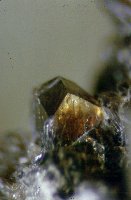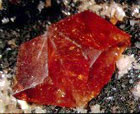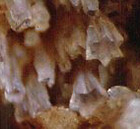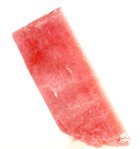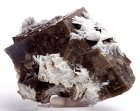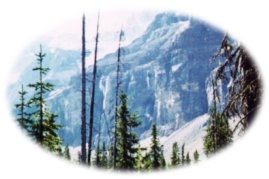

|
Volume 2, Number 1 |
Cover photo: Stanley Glacier Kootenay National Park, Canada Photo by Dirk Schmid |
- Mont Saint-Hilaire
- How Mont Saint-Hilaire was formed
- Collecting at Mont Saint-Hilaire in 1997
- Newly Described Mineral Species from Mont Saint-Hilaire
- Gypsum Rosettes from the Red River Floodway
- Weird and Wonderful Quartz from Alberta
- Meteorites from Antarctica
- New Canadian Website features Unique Jewellery by
Saskatchewan Goldsmith - Field Guide to Gold, Gemstone & Mineral Sites in B.C. Volume 1: Vancouver Island
After several delays, computer problems and juggling time between completing a masters thesis and editing the articles for this issue, the Summer 1998 edition is finally online. Much time and preparation was required to put this issue together. Featured this time is Mont Saint-Hilaire. This famous locality is known for producing fine quality mineral specimens and is a delight for collectors. This issue provides an introduction to the locality and looks at some of the newly described minerals discovered in 1997.
This issue would not have been possible without the help of the Canadian Micro Mineral Association. I am very thankful for their help in reviewing and contributing the articles for the Mont Saint-Hilaire feature. I am especially grateful to Laszlo Horvath who provided me with a summary of collecting activities at Mont Saint-Hilaire in 1997, and also helped in editing the feature. I also thank Mike Skebo, Malcolm Back from the Royal Ontario Museum, Marc Favre, and Martin van Kuilenburg for their help on the feature. Thanks is also given to Ron Zeilstra, Mike Menzies, Rick Hudson, and John Biczok (Mineral Society of Manitoba) who submitted articles for this issue. Doug Miller, Doug Frey, Ron Zeilstra and Marc Favre supplied the high quality photographs for this issue.
I hope you will enjoy this issue of the Canadian Rockhound. Have a good and safe summer!
Dirk Schmid, Editor
E-mail
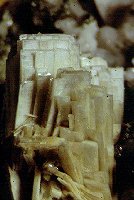 Monteregianite, Mont St-Hilaire, Québec. L. Horváth specimen. Photo courtesy of Violet Anderson, ©1998 R.O.M.
|

Edited by
Laszlo Horvath and Dirk Schmid
Mont Saint-Hilaire
By Marc Favre
Looking east atop Mont Royal on Montréal island, one can make out another monteregian hill 40 kilometers away - Mont Saint-Hilaire. World renowned for its diversity of mineral species and the quality of its crystals, the Poudrette Quarry at Mont Saint-Hilaire, Québec, has become a favored site for mineral collectors.
How Mont Saint-Hilaire was formed
By Martin van Kuilenburg
More than 130 million years ago the area around Mont Saint-Hilaire was covered by a sea. Tectonic forces, rising magma and erosion all helped to form the mountain and its many rare and unique minerals.
Collecting at Mont Saint-Hilaire
in 1997
By Laszlo and Elsa Horvath
In this year-end report, we cover as much as possible all the minerals found at Mont Saint-Hilaire, large and small, with special emphasis on rare and new species and minerals new for the locality.
Newly Described Mineral Species
from Mont Saint-Hilaire
Abstracts by Malcolm Back and Robert Gault
Horváthite-(Y)
Horváthite-(Y) is a newly described mineral species from Mont Saint-Hilaire, Québec. Cotype specimens were collected in 1994 by Stephen and Janet Cares from a heavily altered section of a large pegmatite dike in the southeastern corner of the Poudrette quarry.
Kukharenkoite-(Ce)
This newly described mineral species was found at several type localities in Russia and in Québec. At Mont Saint-Hilaire, this carbonate mineral was found in thin seams in a hornfels xenolith associated with various other minerals.
Lukechangite-(Ce)
Lukechangite-(Ce) is a new and extremely rare carbonate mineral found at the Poudrette quarry, Mont Saint-Hilaire, Québec - the type locality for this mineral. The cotype specimen, now in the collection of the Canadian Museum of Nature, Ottawa, CMNMI 81535, was collected in 1995 by Steve and Janet Cares.
Normandite
Normandite, a newly described mineral species from the Poudrette Quarry, Mont Saint-Hilaire, Québec, is the Ti-analogue of låvenite. The mineral was originally discovered by Charles Normand in 1980 in miarolitic cavities in nepheline syenite associated with albite, kupletskite, natrolite and donnayite-(Y).
Sheldrickite
Sheldrickite is a newly described carbonate mineral species from Mont Saint-Hilaire, Québec. The cotype specimens were collected in 1991 by staff from the Canadian Museum of Nature and by Gilles Haineault. At present it is considered to be very rare.
The UK 58 Group: Quintinite-3T, Charmarite-2H,
Charmarite-3T and Caresite-3T
This new group of carbonate minerals were all found and described from Mont-Saint Hilaire. At Mont Saint-Hilaire these species occur as late-stage hydrothermal minerals in miarolitic cavities and in pegmatite bodies within the nepheline syenite.

 Classic gypsum rosette (selenite), Winnipeg, Manitoba. Photo courtesy of Ron Zeilstra, ©1998. |
Gypsum Rossettes from the
Red River Floodway, Winnipeg, Manitoba
By Ron Zeilstra
Rosettes of gypsum crystals have been found in the banks of the Red River Floodway in Winnipeg, Manitoba since the late 1960's. However, the rosettes are not uniformly distributed throughout the banks of the floodway, but occur in small "pods" of high concentration in certain areas. Reported here are the types of rosettes found in the floodway.
Weird and Wonderful Quartz in Septarian Nodules
from Alberta's Dinosaur Country
By Mike Menzies
In Alberta's badlands one can find a wide variety of interesting and unusual quartz crystals. These are found in abundant ironstone nodules that weather out of steep slopes along the coulees of Meeting Creek and the Battle River. Reported here are the various types of crystals found in the region.
The Search for Shooting Stars: Hunting for Meteorites on the Antarctic Plateau
By Rick Hudson
In 1969 a Japanese scientist picked up 9 rocks from the ice's surface near the Yamato Mountains in Antarctica. Months later, startled researchers realized what he had found - a collection of rare meteorites. Since then over 17,000 meteorites have been found, tripling the known number available to science. Why so many meteorites on this frozen continent, and why study them?
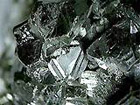 Tetrahedrite, a common copper mineral. Photo courtesy of theImage.com.
|
Tetrahedrite forms a series with tennantite. It has been found in other copper-zinc mines in Manitoba, and in other parts of Canada. Tetrahedrite is also mined because of its high silver content.
Almandine Garnet
Almandine is a very common type of garnet that occurs in metomorphosed rocks. Under unusual conditions, almandine garnets can form large crystals.
Chromite
Chromite is a member of the spinel group, and is the only ore of the metal chromium. Manitoba's Bird River Sill is one of North America's largest and richest chromite deposits.
Tancoite
Tancoite is an extremely rare, fluorescent mineral. It's type-locality and only occurrence is the Tanco Mine, Bernic Lake, Manitoba.
 Pendant with rockpainting design. Photo courtesy of Doug Frey.
|
By Dirk Schmid
For over twenty years Doug Frey, a goldsmith, has designed and produced quality Canadian jewellery pieces in his studio. Doug now offers his jewellery and gemstones through his new Canadian website.
Field Guide to Gold, Gemstone & Mineral Sites of British Columbia, Volume 1:
Vancouver Island
by Dirk Schmid
Reviewed here is a new comprehensive field guide introducing the collector to rockhounding on Vancouver Island. This guide describes over 100 collecting localities and includes maps and prospecting information.

- Hudson, R. 1997. Gold, Gemstone & Mineral Sites of British Columbia. Volume I: Vancouver Island. Orca Book Publishers, Victoria, BC.
- Yorath, C.J. 1997. How old is that Mountain? Orca Book Publishers, Victoria, BC.
- Chesterman, C.W., and K.E. Lowe. 1990. The Audubon Society Field Guide to North American Rocks and Minerals. Alfred A. Knopf, Inc., New York.
- Fleischer, M., and J.A. Mandarino. 1995. Glossary of Mineral Species. Mineralogical Record, Inc., Tuscon, Arizona.
- Gaines, R.V., H. Catherine, W. Skinner, E.E. Foord, B. Mason, and A. Rosenzweig. 1997. Dana's New Mineralogy, 8th ed., John Wiley and Sons, Inc.
- Pough, F.H. 1996. A Field Guide to Rocks and Minerals. 5th ed. Houghton Mifflin Co., New York.
- Sinkankas, J. 1964. Mineralogy. Van Nostrand Reinhold Company.
- Wight, Q. 1993. The complete book of micromounting. Mineralogical Record, Inc., Tucson, Arizona.
- Sinkankas, J. 1977. Gem Cutting: A Lapidary's Manual. 2nd Ed. Van Nostrand Reinhold.
Mont Saint-Hilaire:
The following sources are recommended for those who wish to learn more about the mineralogy and geology of Mont Saint-Hilaire:- Currie, K.L. 1970. An hypothesis on the origin of alkaline rocks suggested by the tectonic setting of the Monteregian Hills. Canadian Mineralogist 10:411-420.
- Henderson W. 1982. Microminerals: Mineral paragenesis at Mont St.-Hilaire. Mineralogical Record 13:241-247.
- Horváth, L., and R.A. Gault. 1990. The mineralogy of Mont Saint-Hilaire Québec. Mineralogical Record 21:284-359.
- Horváth, L., E. Pfenninger-Horváth, R.A. Gault, and P. Tarassoff. 1998. Mineralogy of the Saint-Amable Sill, Varennes and Saint-Amable, Québec. Mineralogical Record 29(3):83-117.
- Mandarino J.A., and V. Anderson. 1988. Monteregian Treasures: The minerals of Mont Saint-Hilaire, Québec. Cambridge University Press, New York.
- Perrault, G., and J.A. Mandarino. 1972. The Monteregion Hills: Mineralogy of Mount St. Hilaire. International Geological Congress, XXIV, excursion guidebook B-15.
- Pouliot, G. 1962. The thermal history of the Monteregian intrusives based on a study of the feldspars. Ph.D. Thesis, McGill University, Montréal, Canada.
- Rajasekaran, K.C. 1966. The petrology of nepheline syenites at Mount St.Hilaire. Ph.D. Thesis, McGill University, Montreal, Canada,.
- Wight, Q. and G.Y. Chao. 1995. Mont Saint-Hilaire Revisited, Part 2. Rocks & Minerals 70(2):90—103, and 131—138.


Copyright © 1998 Canadian Rockhound
Website created by Dirk Schmid
Images of minerals copyright © 1997-98
Royal Ontario Museum
unless otherwise noted. Used with permission.
Magazine Issues |
News & Events |
Junior Rockhound |
Resources
Clubs |
Dealers |
Classifieds |
Web Links |
Home
